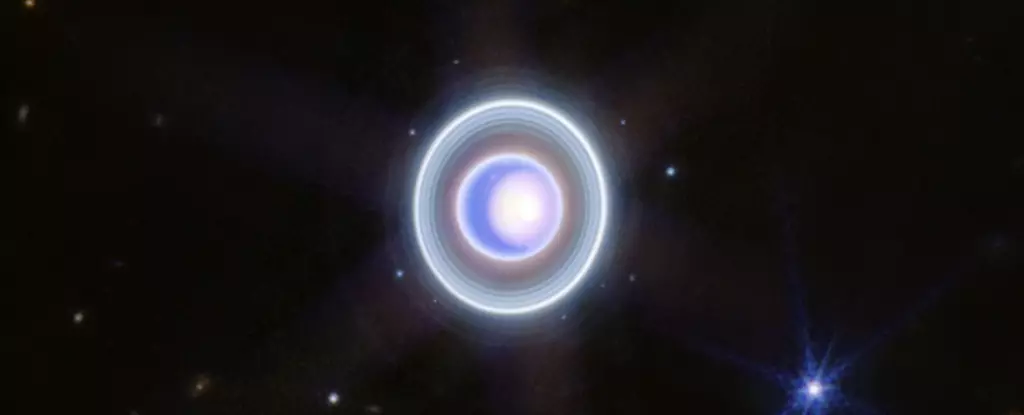For over three decades, Uranus has captivated planetary scientists with its eccentricities, notably its unusual magnetic field. Originally explored by Voyager 2 during its historic flyby in 1986, the unique properties of Uranus’s magnetosphere have led to myriad questions regarding the planet’s behavior and internal mechanics. Recent research spearheaded by NASA’s Jamie Jasinski suggests that previous interpretations of Voyager 2’s data may have overlooked crucial factors, unveiling a potential misrepresentation of Uranus’s magnetic characteristics.
When Voyager 2 passed by Uranus, it delivered the first and most significant measurements of the planet’s magnetic field, presenting a chaotic environment unlike any within our Solar System. The spacecraft’s data indicated that the magnetosphere was not only displaced from the planet’s center but also appeared to be functioning under unusual conditions. In the years that followed, this initial data shaped scientific understanding of Uranus, bearing extensive implications for theories about the planet’s history and atmosphere. However, Jasinski’s recent exploration of this data raises the tantalizing possibility that these observations may have been influenced more by temporary solar conditions than by the planet’s intrinsic characteristics.
The turning point in Jasinski’s research came from a careful analysis of solar wind activity leading up to Voyager 2’s encounter with Uranus. Historical data indicated a substantial increase in solar wind pressure just prior to the flyby, with measurements showing an extraordinary spike by a factor of twenty. This sudden solar outflow would have dramatically altered the environment surrounding Uranus, compressing its magnetosphere to just twenty percent of its usual volume. This phenomenon suggests that the magnetic disruptions observed during the Voyager 2 flyby could be anomalies rather than the sustained characteristics of the planet.
Jasinski expressed a pivotal realization: “The flyby occurred under very special circumstances where fresh data could lead to a misinterpretation of Uranus’s magnetic environment.” Such insights necessitate a reassessment of how we understand not only Uranus but also the nature of magnetospheres around gas giants generally.
This new perspective compels scientists to reconsider long-held assumptions about Uranus’s magnetic field generation within the planet. Prior conclusions posited that Uranus possessed a unique internal structure responsible for its atypical magnetic field. If Jasinski’s insights hold true, then Uranus may not be as singular in its magnetic dynamics as previously thought. Instead, its magnetic behaviors could resemble those of other gas giants in the Solar System under normal solar wind conditions.
Furthermore, this reevaluation hints at a broader importance of context in interpreting planetary data. It illustrates how transient solar phenomena, often overlooked, can dramatically manipulate measurements and lead to flawed conclusions about planetary geology and atmospheres. The continued exploration of Uranus and Neptune, through future missions, is crucial for gathering comprehensive data that would support or refute these emerging hypotheses.
Given these revelations concerning the Voyager 2 data, there exists a compelling case for renewed exploration of Uranus and its moons. Scientists have long advocated for missions targeting these icy giants, emphasizing the importance of acquiring more extensive data for clearer interpretations of their composition and behavior. A reevaluation of the Uranus system could unveil ongoing geological activities that were obscured due to prior solar influences during the Voyager 2 encounter.
As Jasinski notes, “The drastic squashing of the magnetosphere could have obliterated valuable signs of activity from the moons.” This indicates the potential for significant research breakthroughs regarding the satellite system of Uranus, offering new insights into their geological and atmospheric conditions. Future missions could fundamentally shift our understanding of Uranus as a planet and clarify the dynamic relationships between each of its moons.
Uranus, with its avenues of intricate mysteries, reveals much about the nature of our Solar System. As we gather more data, we are reminded of the fundamental principle that planetary exploration is replete with surprises. The cutting-edge analysis stemming from Voyager 2’s findings signals a shift in how scientists perceive Uranus, advocating for a landscape of exploring instead of just observing—an approach that can unlock many secrets held tightly within the depths of our cosmic neighborhood.
As research continues to unravel the layers of complexity surrounding Uranus, we stand on the brink of understanding a planet that, for too long, has been shrouded in enigma. The future holds immense promise, and as humanity strives to decode Uranus’s mysteries, we inevitably unearth not only knowledge about the planet but also about our home within the Solar System.


Leave a Reply